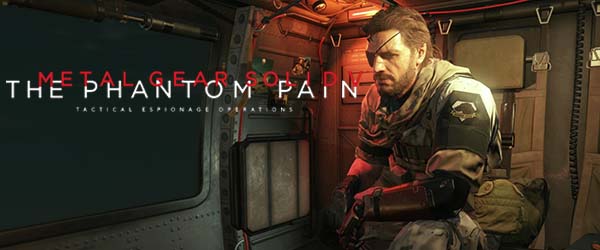
It took months, but I finally finished and reviewed Metal Gear Solid V. It was a tough game to review, mostly because my dreams for an epic conclusion to the Metal Gear franchise seem to have been dashed by corporate stupidity forcing the game to be released before it was finished. Maybe Kojima (and Konami) have some elaborate trick up their sleeve, and there's going to be some crazy patch that replaces the recycled missions in Chapter 2 with real missions, and which adds the missing third chapter and the "Kingdom of the Flies" mission. Unless that happens, I'm going to operate under the assumption that the recycled missions of chapter 2 were put in as placeholders for missions that were planned but never completed. And I have some ideas of what a couple of those missions might have been about.
There's half of Foxhound from Metal Gear Solid 1, right there!
After retrieving the microfilm in mission 38, you get a couple of intel tapes that might inform exactly what chapter two was supposed to be about.
Informant's Report: Part 2 talks about the "Third Boy", who is a young Psycho Mantis. The first part of the tape reveals details on how Psycho Mantis' powers work. The second part is a bit more interesting, as it poses the conjecture that Eli was projecting his will onto the Third Boy, and controlling Sehalanthropous. This establishes how Eli (who would later be revealed to be Liquid Snake) begins his partnership with Psycho Mantis, the first recruit in his Foxhound team that would eventually take over Shadow Moses in the first Metal Gear Solid game.
Was mission 40 supposed to be about Sniper Wolf?
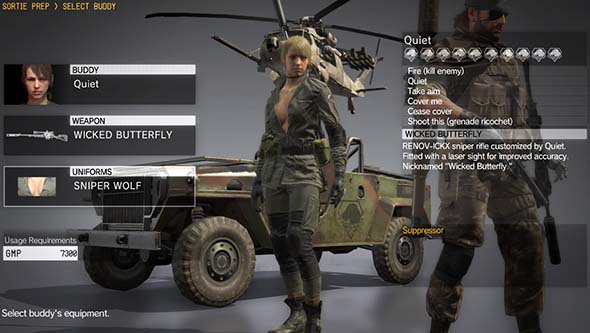
Obtaining Sniper Wolf's handerchief from the retread of "Cloaked In Silence" unlocks the Sniper Wolf costume.
With that in mind, let's take another look at mission 40. It's a repeat of mission 11: "Cloaked In Silence". It's a repeat of the sniper battle with Quiet, complete with the same mission briefing and even repeating the cutscene of Quiet shooting down the pursuing plane on the way back to Mother Base. All the repeat missions in chapter 2 are reproduced verbatim from the original mission, right down to the bookending cutscenes (even though they make absolutely no narrative sense). But there's two interesting things about mission 40 that make it stand out. The first is that Quiet isn't wearing her regular bikini outfit. She's wearing a jumper - Sniper Wolf's jumper from Metal Gear Solid 1. She even has blonde hair. Secondly, completing the mission awards the player with a Handerchief item that allows Quiet to be equipped with the Sniper Wolf outfit.
Is this a simple fan-service Easter Egg? Or was Mission 40 supposed to be a battle with a young Sniper Wolf that would establish how Eli [Liquid] and Sniper Wolf first met?
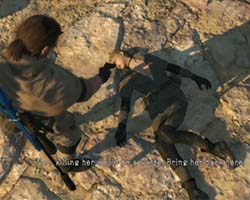
Quiet even wears this uniform during the battle.
Sniper Wolf was born in Iraq, and she grew up amongst military conflict, she moved around the Middle East and Africa frequently to avoid the authorities, and she was eventually rescued from that life by Big Boss. So her backstory is actually a near perfect match for an appearance in Phantom Pain! Maybe Iraq was supposed to be a third area of operations? Mission 40 could have been intended to be a mission in which the player finds a young sniper wolf, engages her in battle to test her ability, and then captures and recruits her. Kojima may not have had time to finish this mission, and so Quiet's alternate outfit model was used instead, and Quiet's duel mission became a place-holder.
I would expect that if a young Sniper Wolf had been planned, then Kojima would have already cast a voice and mo-cap artist. But as far as I know, nobody has found assets for any character model or dialogue from any one who could qualify as a young Sniper Wolf. IMDB does list some voice actresses for various soldier roles, but no young girls other than Paz's voice (from Tara Strong). But if the game is truly unfinished, and whole chapters hadn't even been developed yet, then it's possible that such casting simply hadn't happened yet. If early rumors of the mission list are true, then the game wasn't nearly as far along as we think. That mission list, by the way, has a mission late in the game called "Beauty of the Battlefield", which could be a prime candidate for the mission that would have introduced a young Sniper Wolf, and the fact that it takes place during a chapter called "The Cost of Revenge" could also be appropriate to Sniper Wolf's story. Though, this mission could also just have easily been a mission about Quiet.
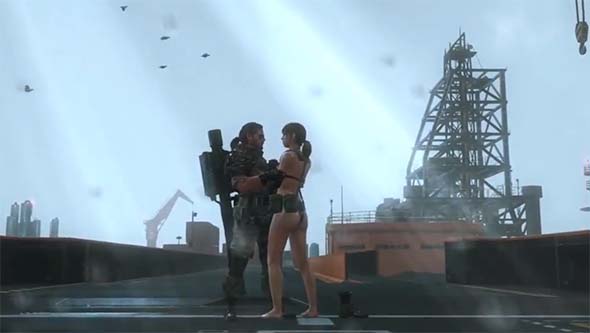
It is implied several times by behavior and dialogue that Quiet has romantic feelings for Snake.
Alternatively, the intent of establishing a link between Quiet and Sniper Wolf might be to imply that Quiet is Wolf's mother. There are hints of a possible romance between Quiet and Venom Snake. Ocelot suggests that Quiet might not have killed Snake because she likes him as early as right after you bring her back to base. There's the infamous "playing in the rain scene", and her final casette tape after "A Quiet Exit" even says that she has "feelings" for Snake. And then, of course, there's her suggestive poses in the brig and helicopter. It's possible that there could have been a point during design in which they were planned to have a romantic relationship and possibly even a child together (assuming Quiet is even capable of conceiving and bearing children in her condition). Alternatively, Quiet could have mothered Sniper Wolf prior to the operation in Cyprus. Her injuries during that operation, and abduction and experimentation by Cipher and Skull Face could have separated her from her young child and left Sniper Wolf an orphan... [More]
253e7ff0-092e-4d52-b340-0ef9d897fafa|0|.0
Tags:Metal Gear Solid, Metal Gear Solid V: the Phantom Pain, Foxhound, Eli, Liquid Snake, Revolver Ocelot, Third Boy, Psycho Mantis, Quiet, Sniper Wolf, handerchief, sniper, Vulcan Raven, raven, Decoy Octopus, Gray Fox, Shadow Moses

Are you one of the poor suckers who paid $30-40 for Ground Zeroes and were ready for The Phantom Pain to make up for your disappointment with what was little more than a glorified (and over-priced) demo? I wasn't, because I got Ground Zeroes for free from my PSPlus subscription around the same time that Phantom Pain was released. I was obviously disappointed with the demo's short length, and I didn't bother doing any of the side missions. But since I didn't pay for it, I wasn't as enraged as some other players might have been.
I actually really liked what little gameplay Ground Zeroes had to offer. The Guantanamo Bay arena was well-designed and offered some good infiltration challenge that tested my Metal Gear capabilities. The A.I. was surprisingly competent and adaptive - not so much that I couldn't exploit them occasionally, but still good. The graphics, lighting, and weather effects all looked outstanding. It was a fun experience. Not "forty dollars fun", but pretty fun. At least part of the battle at Mother Base should have been playable, and I didn't like that large elements of the story were hidden away in collectible audio tapes, but whatever.
I got Ground Zeroes for free on PSPlus, instead of paying $30-40 MSRP for a glorified demo.
Ground Zeroes gave me flashbacks to the phenomenal classic Sons of Liberty demo that came packaged with Zone of the Enders on the PS2. At least that only cost me a $3 rental, and I got to play Zone of the Enders too. After Ground Zeroes, I was looking forward to getting my hands on the much bigger Phantom Pain, and was optimistic that it would provide an equally good experience that would be worth the purchase price. Phantom Pain is a very long, very complicated, and very uneven game. So buckle up, friend. This is going to be a long review.
Table of Contents
After having written a lengthy blog post about how open world, sandbox game design almost necessarily puts the game's narrative in a state of limbo, I was amazed to start up Metal Gear Solid V and see the very first mission took my criticisms to heart. Of course, the game had already been released by the time I had written that opinion piece, so I can't take credit for having influenced its development, but it was still refreshing and gratifying. Anyway, in the very first mission, Ocelot tells you that Miller has been captured by Soviets in Afghanistan, has been tortured for intel, and has three days - tops - to live. You must rescue him before that time.
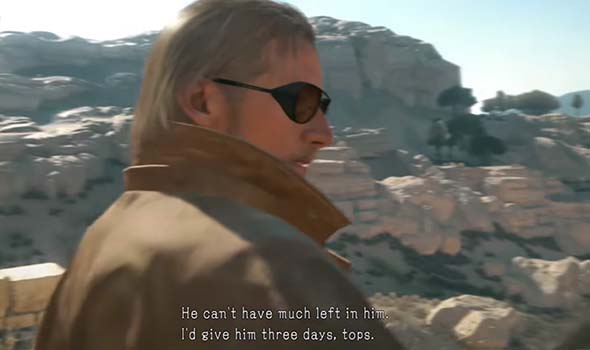
Ocelot gives the player three days to rescue Miller...
At first, I didn't put much stock in Ocelot's claim. After all, sandbox games are notorious for saying that something needs to be done ASAP, but they never have the balls to actually walk the walk and enforce that objective. Until now. When checking my map, I noticed something in the corner that I hadn't noticed in other sandbox games before: an "elapsed time" counter. The game was plainly tracking how long it was taking me to complete the primary mission objective. I treated this timer with a certain degree of skepticism. But sure enough, failure to rescue Miller within the allotted time actually results in a "Game Over"!
This is exactly how I feel that priority objectives in open world games should be handled: make it apparent to the player (through dialogue and/or explicit notification) that an objective is being timed or that it is otherwise a priority, and make sure that there are reasonable, perceivable consequences for failure to achieve that objective within the expected conditions. Then design some early-game quests or objectives such that the player is put in a position in which they can (or must) fail; thus, teaching the player that when the game says "do x or else", the game actually means it. I put down the controller and gave Hideo Kojima a standing ovation. But would this opening mission set a precedent that priority missions must actually be prioritized, and would that precedent stand throughout the rest of the game? Or was this just a one-off occurrence that would not be representative of the rest of the game? Regardless, a tone was plainly set for the rest of the game, and the stakes had been raised.
... Failure to rescue Miller within the allotted time results in his death and a Game Over.
Would this refreshing precedent carry over into the rest of the game? Well, sort of... [More]
11c3f412-b61e-422f-96c9-742ddb50d6fb|5|4.2
Tags:Metal Gear, Metal Gear Solid, Metal Gear Solid V: the Phantom Pain, Konami, Hideo Kojima, Fox Engine, tactical espionage operations, tactical espionage action, espionage, stealth, snake, Big Boss, Revolver Ocelot, Quiet, dog, Diamond Dogs, Afghanistan, Africa, open world, desert, sandbox, Fulton Recovery System, balloon, horse, Mother Base, helicopter, Soviet Union, Skull Face, Cipher, Zero, Sahelanthropus, Keifer Sutherland, David Hayter, ludonarrative, ludonarrative harmony, FOB, online, PvP, Metal Gear Online

While I was playing through recent horror titles like The Evil Within, I noticed some interesting similarities with Silent Hill 4 that started to give me a new appreciation for some of this game's stronger aspects. In addition, while doing research for my Silent Hill timeline, I had to go back and play through Silent Hill 4: the Room again. I had only played through the game twice before, so I had to replay it in order to figure out how the timeline would work out. And while I was playing the game, I figured that I might as well go ahead and review it. At the time, it seemed like a novel idea to do a retro review of a Silent Hill game that wasn't Silent Hill 2, but lately, I've been seeing a lot of retro-reviews of The Room popping up other places. I haven't done any retro reviews yet; probably the closest thing has been my review of Demon's Souls. But in light of how unsuccessful the later Silent Hill games have been, the unfortunate cancellation of Silent Hills, and the uncertain future of the franchise (and of Konami as a studio), it's a good time to go back to look at what worked and what didn't about the previous games, and explore the question of whether we even want the franchise to continue.
The Room has the reputation of being the "bad" black sheep of the original Silent Hill tetralogy. I always thought that this reputation was unfortunate, and that the game wasn't quite as bad as people made it seem. I actually liked it better than Silent Hill 3 when I first played it, because I had never played the first Silent Hill. After I was able to track down a copy of the first game and play through it, Silent Hill 3 suddenly made a whole lot more sense, and I came to love it almost as much as I loved Silent Hill 2. So while I tend to agree that The Room is the "weakest" of the original Silent Hill games, I never really thought of it as being "bad"; just "less good". The release of future games by third party developers has only made The Room look better in retrospect.
An experimental formula
The game itself is a bit rough around the edges. It deviates significantly from the controls and mechanics established by the previous games in the franchise, and these changes are very hit-or-miss. This might be due, in part, to the possibility that The Room started out as an independent side project that was developed concurrently with Silent Hill 3, and that was eventually redesigned to work as a Silent Hill game in order to be more commercially viable. Whether or not that's true is still a hot issue of debate among the fanbase, but it's obvious to everybody that The Room plays a lot differently from previous titles.
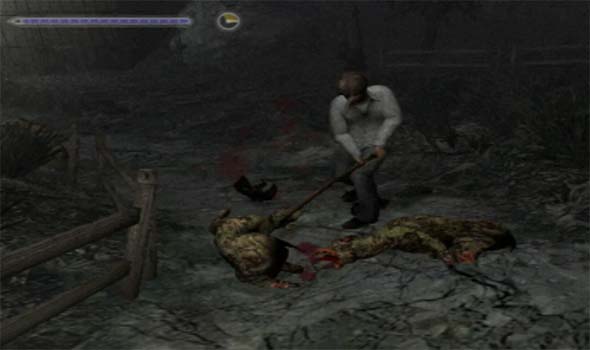
Movement and combat controls are radically changed from previous games in the series.
The most immediately obvious deviation is in movement and camera controls. The semi-first-person "tank" controls have been completely abandoned in favor of direct directional inputs, and the camera is significantly more limited than it has been in previous games. You can't snap the camera behind the character by holding the "look" button as you could do in previous games. Almost all camera angles are pre-set angles, and the player can usually only toggle between two possible camera angles in any given area.
This results in some very clumsy navigation of the environment, and it's very easy for the character to get turned around when camera angles flip. Most of the time, a camera change will go without a hitch, but there are a few frames in the game that consistently result in erratic and unpredictable movement. It happens most often when a camera change occurs concurrently with a change in direction of the character (to navigate around a corner or an obstacle). If the player's timing for changing the character's movement direction is not perfectly-timed, then the character ends up turning around, which can result in getting stuck in a loop between the two camera angles. This is the very reason that I prefer the tank controls. They may be a bit cumbersome, but at least they're consistent and always relative to a single frame of reference (the character's position in the world), rather than to an unpredictable camera.
The second major change is to combat. The game was designed to have a greater emphasis on melee combat, complete with new target-locking controls, a variety of breakable melee weapons, very limited ammunition for guns, and an on-screen meter for charging power attacks. The new movement controls do make it a bit easier to maneuver around enemies (especially multiple enemies), but only if you're in an open space and the camera angle doesn't go all wonky on you. The mechanics are serviceable, and I don't think they're as bad as some critics insist.
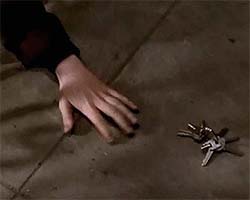
The designers were probably trying to mimic
the horror trope of fumbling for keys.
Inventory management is where things really start to get bad. Henry isn't a walking closet like the previous games' protagonists, and he has only a limited number of inventory slots. This is probably partly the result of the inventory being accessed in real-time by the directional buttons (which also might have played a role in the changes to the movement control scheme being entirely based up on the analog stick), in a desire to create a sense of frantically searching your pockets for a weapon or item while under pressure. It also adds more relevance to the Room 302 hub (another dramatic departure from previous games) by forcing you to go back to restock on supplies or swap out puzzle items.
But it's hindered by a lot of little mistakes... [More]
a5ccd49d-8af1-4839-8eb0-2796d3829980|6|4.5
Tags:Silent Hill, Silent Hill 4: the Room, Konami, Team Silent, KCET, Henry Townshend, Walter Sullivan, Eileen Galvin, room 302, horror, serial killer, murder, cult, occult, 21 Sacrements, sacrifice, ritual, ghost, escort quest, Alfred Hitchcock, retro review
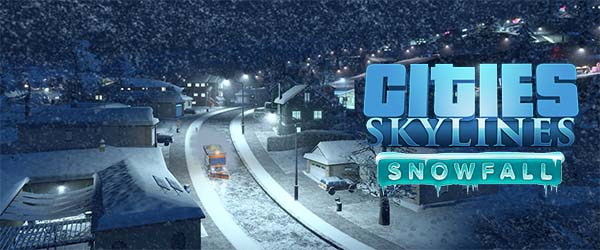
I described Cities: Skylines' first expansion, After Dark, as " just tak[ing] the Cities: Skylines canvas, and offer[ing] the player a few more colors to optionally paint with." That expansion didn't really do much to change the way that the game is really played, but rather just focused on adding further specialization options for any city that you care to build. I wasn't too upset because the core game is still a phenomenal foundation to build upon, and the expansion just gave us more to play with within that same phenomenal foundation. Snowfall, however, is even more narrow in scope. It offers one new color to paint with, and that color is white.
I got really excited when I loaded up Steam and saw the title of the new expansion. I had written a wishlist blog in which I specifically asked for the next expansion to offer seasonal weather changes and more recreational and transportation specializations suited to those different seasons. On the surface, Snowfall seemed to provide that. There's now a winter, and snow, and you can build a specialized winter wonderland. But that's the extent of what this expansion provides, and that's disappointing.
Snowfall doesn't provide a full season system or any real changes to the game's core economic loop. Instead, it has a few snowy, winter-themed maps in which you can build snow-themed cities. Those winter maps are always snowy, and the non-winter maps are never snowy (although they can see occasional rain and fog). Note: I'm going to get real tired of saying "non-winter maps", so henceforth, for the sake of simplicity, I will refer to them as "summer maps", even though summer isn't really a thing (yet). Your city doesn't progress from springing to summer to autumn to winter (or even just from summer to winter) and then back again, and you don't have to manage your economy so as to maximize profits during your tourist season and find a way to maintain employment and revenue during the off season. Depending on which map you select, it's either always winter, or it's always summer.
I complained about After Dark feeling like I had to go out of my way in order to use the expansions new features and specializations, but at least those features and specializations were available in all cities, and they could be applied to my existing cities from before the expansion. You have to go so far out of your way to use the Snowfall features that you have to start a whole new game on a specific subset of maps. It makes After Dark look like a broad game-changing expansion by comparison.
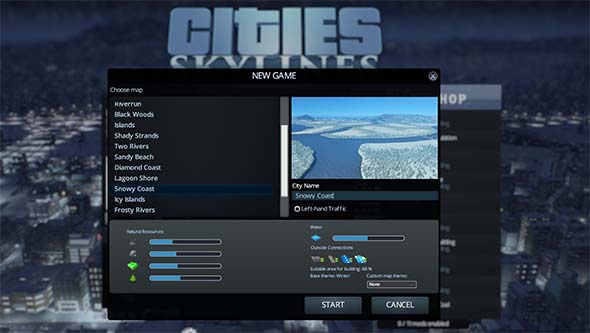
Only maps designated as "winter" maps will have snowfall, and they aren't very different from existing maps.
Disconnected from reality
The actual functionality of some of these winter buildings is also questionable. One of the first snow buildings that you'll unlock is the "snow dump", which is a landfill for snow. Snow plows in this game will drive around the city similar to garbage trucks, actually collecting the snow off the streets, and then taking them back to the snow dump building, which (according to its description) melts down the snow to make room for more snow. It seems like they just took the garbage truck functionality and copy-pasted it to apply to snow, only without the need for a separate incinerator building.
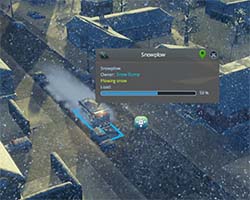
Snow can slow traffic and must be plowed.
The really weird thing is that there is also a new general road maintenance office that keeps the roads in good repair and traffic flowing smoothly. If you don't bother to build the road maintenance office, or build the snow dump or plow the snow, it will slow down your roads and eventually make them unusable. Why did these need to be two buildings? Why couldn't the road maintenance office also be the depot for snow plows?
And then there's the ski buildings, which also don't seem to work in any way comparable to real life. The ski resort is an artificial ramp that you build on flat ground. Again, that's not really how ski resorts work. Typically, a ski resort would be built high up on a mountain, where there's a natural slope and a lot of snow. The game does include a separate ski lodge building, which you could build up in a mountain, but it wouldn't work all that well. It seems to me that the Ski Resort shouldn't be a ramp, it should just be the ski lift that you build on inclined terrain, and the Ski Lodge should be built nearby and should enhance the functionality of the resort. In fact, the new snow maps don't even include mountainous terrain on which to build a more realistic ski resort and lodge. So this all seems to be a result of the game's underlying framework not having very good support for building on slopes, and Colossal Order didn't bother to design a system to allow such niche buildings like a ski resort to be built on a slope.
I may live in a desert, but I'm pretty sure that this isn't how snow plowing or ski resorts are supposed to work...
Look, I live in the desert of Las Vegas, where it was 80 degrees by mid-February, and air conditioning is not an "option" for a car. Maybe it's not my place to tell a development team in Finland how ski resorts and snow plowing are supposed to work, but I'm pretty sure that this isn't how ski resorts and snow plows work!
Don't get me wrong, these buildings are all functional, and they all work within the game's existing mechanic set. It isn't like they are broken; they're just not very realistic, and they have a disappointing feeling of sameness to them, since they don't feel functionally distinct from buildings and features that already exist. For games like this, I tend to lean towards wanting more realism whenever possible, but that's a subjective personal preference. I understand that this is just a game, and certain amounts of abstraction and creative license need to be taken... [More]
1d6478f3-d83d-487b-a545-922d69eb8b1b|6|4.2
Tags:Cities: Skylines, Cities: Skylines: Snowfall, expansion, Paradox Interactive, Colossal Order Ltd., PC, Steam, Steam Workshop, city simulation, weather, snow, rain, fog, skiing, snowboarding, sky resort, ski lodge, heating, geothermal, cold, temperature
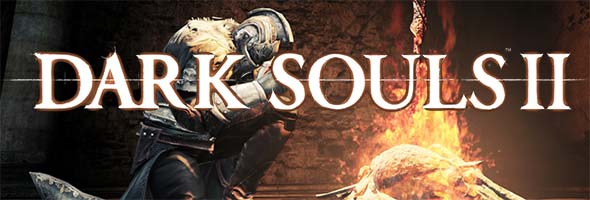
I've been trying to get myself hyped up for Dark Souls III by playing through the Scholar of the First Sin edition of Dark Souls II. I made myself a knight character as well as a sorcerer character. I hadn't played as a dedicated caster in the original release, so I made the sorcerer my primary character for Scholar.
So I put myself through the misery of trying to farm the Lizard Staff for my sorcerer character. This staff is one of the three or four best staves in the game (for Int-based sorcerers), but it's extremely rare. It is only dropped by the two Hollow Black Mages that accompany the Executioner's Chariot in the Undead Purgatory. So it's only even possible to acquire in this one, specific location in the game, and once you beat the boss, the mages don't respawn. So it's even harder than trying to farm the Sea Bow or other such items, because you can't simply go back to the area later and farm the enemies.
To make matters worse, I didn't realize that this staff could be acquired here, so I made the mistake of killing the boss early in the game (before I had equipment to raise my item discovery rate). So the only way for me to acquire this staff now would be to warp to the Undead Purgatory bonfire, use a Bonfire Ascetic to respawn the boss, fight may way back through the Huntsman's Copse, and hope to get the rare drop. I had to fight harder versions of the Purgatory Executioners. It was tough, but doable. I was able to lure them out one at a time and easily dispatch them. It's only if they ganged up on me that I had problems. But then I also had to get past the Red Phantom Tower Knight (who now respawns because of the Bonfire Ascetic). I died several times trying to run past them all, as the Tower Knight's weapon tracking was pretty spot-on. Eventually, I resorted to spell-sniping him from just outside his pursuit range. It was cheap, but I wasn't here to fight, I was here to farm a staff.
The Lizard Staff and Sea Bow are among several items in Dark Souls II that are extremely rare drops.
Then I made it into the Executioner's Chariot boss fight, and I died. And then I died again. And again. This was getting tedious.
Bonfire Ascetics, Soul Memory, and grinding / farming in Dark Souls II
I hate grinding and farming in games. I really do. It's something that I really don't think games need to have anymore. It was something that worked fine when games were relatively short, and grinding or farming for obscure items and secrets was a challenge reserved for the most dedicated players. But Dark Souls II is already long enough without including grinding for hours for rare item drops. It's one thing to hide items behind secret bosses or particularly tough challenges, such that the item is a symbol for overcoming a challenge. It's a totally different thing to hide items behind random drops from enemies that appear literally in one spot in the entire game, and who despawn after beating them.
In Dark Souls II's case, there's even mechanical reasons why this sort of grinding or farming should not be in the game. And that reason is Soul Memory... [More]
67cbe268-c8f0-446d-b36e-1cf6e7d9ec41|4|4.3
Tags:Dark Souls, Dark Souls II, Dark Souls II: Scholar of the First Sin, Scholar of the First Sin, Lizard Staff, sorcerer, mage, Huntsman's Copse, Undead Pergatory, Executioner's Chariot, skeleton, yearn, spell, amber herb, rusted coin, bonfire ascetic, soul memory, farming, grinding, PSN, PSPlus, cloud, PS4, Hidetaka Miyazaki
|

| 12 | | | | | | | 60 | | 11 | | | | | | | 55 | | 10 | | | | | | | 50 | | 09 | | | | | | | 45 | | 08 | | | | | | | 40 | | 07 | | | | | | | 35 | | 06 | | | | | | | 30 | | 05 | | | | | | | 25 | | 04 | | | | | | | 20 | | 03 | | | | | | | 15 | | 02 | | | | | | | 10 | | 01 | | | | | | | 05 |
|